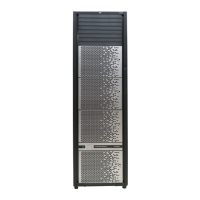Mounting and verifying the file systems
After the mount directories have been created, mount and verify the file system for each logical
volume.
To mount and verify the file systems:
1. Use mount to mount the file system for the volume.
Example
# mount /dev/vg06/lvol1 /AHPMD-LU00
2. Repeat step 1 for each logical volume on the disk array.
If you need to unmount a file system, use the unmount command.
3. Use the bdf command to verify that the file systems are correct. The capacity is listed under
Kbytes.
Example
# bdf
Filesystem Kbytes used avail %used Mounted on
/ldev/vg00/lvol1 59797 59364 0 100% /
:
/ldev/vg06/lvol1 2348177 9 2113350 0% /AHPMD-LU00
4. As a final verification, perform some basic UNIX operations (for example file creation, copying,
and deletion) on each logical device to make sure that the devices on the disk array are fully
operational.
Example
#cd /AHPMD-LU00
#cp /bin/vi /AHPMD-LU00/vi.back1
#ls -l
drwxr-xr-t 2 root root 8192 Mar 15 11:35 lost+found
-rwxr-xr-x 1 root sys 217088 Mar 15 11:41 vi.back1
#cp vi.back1 vi.back2
#ls -l drwxr-xr-t 2 root root 8192 Mar 15 11:35 lost+found
-rwxr-xr-x 1 root sys 217088 Mar 15 11:41 vi.back1
-rwxr-xr-x 1 root sys 217088 Mar 15 11:52 vi.back2
Setting and verifying the auto-mount parameters
Set up and verify the auto-mount parameters for each new volume. The /etc/checklist file
(which can also be called the /etc/fstab file) contains the auto-mount parameters for the logical
volumes.
24 HP-UX

